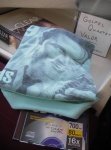journey on
New member
This seems to be the year everything on the boat went pearshaped. This topic covers the bearings on the E-Z Loader trailer. Pat Anderson and I bought our boats about the same time: ~5 years ago. We are both hauling a CD-25. Pat has a King and I have an E-Z loader. The axle bearings should be the same, as for most other heavy duty trailers. Pat did the right thing and went to a trailer repair place. I've changed my own, and I'm going to share that experience. Ready or not. Especially if your boat trailer is 5 or more years old. Even if you have someone else do it, the information may be helpful. Again, it may not.
First, the bearings were changed by EZ Loader right after I got the boat, so we can count on the fact that they lasted 5 years. And only have ~20,000 miles on them. So I was surprised when I drained the oil bath hubs and found silver in the oil. I pulled the hubs and found that both the rollers and races were galled and starting to disintegrate. No failures, just worn out. Thank goodness I got them in time. And one had a leaking seal, which means a new brake pad. The bearings were a Chinese brand. The hubs never got hot, just wear. The oil bath hubs showed no signs of water intrusion.
Now for getting new bearings. Bear with me. Note that this is the first time I've ever had to replace bearings on a trailer, travel or boat. And that includes one boat as heavy as the CD-25. So I'm looking for “good” bearings. The local truck/trailer supply sold me on Timken bearings, saying they were the best and not from China, though imported. Finally got some, but I had to search for a dealer through the Timken web site. Some of the bearings I got were made in the USA, some in Poland.
Here are the sizes for the bearings and seal. Since bearings are standard, the P/Ns are the same for all, just the mfg name changes. As we should be all be aware, each bearing has a outer race and the inner rollers and race.
Outer bearing:
Inner Roller Assy P/N 67048 Outer Race P/N 67010
Note: Timken prefix is LM (Light-Medium duty,) set P/N is SET 6
ID 1.2500 in OD 2.3280 in thickness 0.625
Inner Bearing
Inner Roller Assy P/N 25580 Outer Race P/N 25520
ID 1.7500 in OD 3.2650 in thickness 0.9375
Inner seal: Rubber coated is the only way over straight metal.
P/N Dexter 010-010-00 (Taiwan)
These are Reliable oil filled hubs and I use (per E-Z Loader recommendations) SAE 80W-90 Gear Oil. This is probably better than the 50W engine oil that Reliable recommends, since it's designed to lubricate bearings and gears. If your bearings are grease lubricated, remember to pack them before installing them.
Since a seal leaked, I needed 1 new brake pad. They come in axle sets of 4. The calipers are Kodiak.
P/N Kodiak 225.
I leave the mechanics of changing everything to thee.
Boris
First, the bearings were changed by EZ Loader right after I got the boat, so we can count on the fact that they lasted 5 years. And only have ~20,000 miles on them. So I was surprised when I drained the oil bath hubs and found silver in the oil. I pulled the hubs and found that both the rollers and races were galled and starting to disintegrate. No failures, just worn out. Thank goodness I got them in time. And one had a leaking seal, which means a new brake pad. The bearings were a Chinese brand. The hubs never got hot, just wear. The oil bath hubs showed no signs of water intrusion.
Now for getting new bearings. Bear with me. Note that this is the first time I've ever had to replace bearings on a trailer, travel or boat. And that includes one boat as heavy as the CD-25. So I'm looking for “good” bearings. The local truck/trailer supply sold me on Timken bearings, saying they were the best and not from China, though imported. Finally got some, but I had to search for a dealer through the Timken web site. Some of the bearings I got were made in the USA, some in Poland.
Here are the sizes for the bearings and seal. Since bearings are standard, the P/Ns are the same for all, just the mfg name changes. As we should be all be aware, each bearing has a outer race and the inner rollers and race.
Outer bearing:
Inner Roller Assy P/N 67048 Outer Race P/N 67010
Note: Timken prefix is LM (Light-Medium duty,) set P/N is SET 6
ID 1.2500 in OD 2.3280 in thickness 0.625
Inner Bearing
Inner Roller Assy P/N 25580 Outer Race P/N 25520
ID 1.7500 in OD 3.2650 in thickness 0.9375
Inner seal: Rubber coated is the only way over straight metal.
P/N Dexter 010-010-00 (Taiwan)
These are Reliable oil filled hubs and I use (per E-Z Loader recommendations) SAE 80W-90 Gear Oil. This is probably better than the 50W engine oil that Reliable recommends, since it's designed to lubricate bearings and gears. If your bearings are grease lubricated, remember to pack them before installing them.
Since a seal leaked, I needed 1 new brake pad. They come in axle sets of 4. The calipers are Kodiak.
P/N Kodiak 225.
I leave the mechanics of changing everything to thee.
Boris

